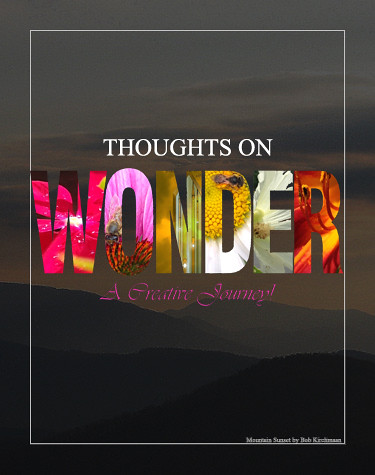
Volume XII, Issue XI
Thoughts on WONDER
The world will never starve for want of wonders; but only for want of wonder.” ― G. K. Chesterton
There is a kind of happiness and wonder that makes you serious. It is too good to waste on jokes.” -- C. S. Lewis
This coming Saturday, October 15th marks the 'official' opening of my show: WONDER in the gallery space at Tabor Presbyterian Church (directions) in Crozet, Virginia. The artist reception is from 3:00pm to 6:00pm that day and if my family previews have been any indication, you will enjoy the show. I already have a lot of great photos of guests interacting with the show, but will only publish them after the show has opened lest some think that they've 'seen it' and miss the actual experience.
WONDER is not, as some might suppose, a retrospective show, nor is it simply about the photography that I have taken up of late (though some is certainly included). Nor is it a collection of old architectural renderings (though some of those can be seen as well).The show is really about WONDER (as its name suggests), VISION, IMAGINATION and DISCOVERY. This issue of THYME is sort of a companion piece, if you will. The articles that follow are a bit of the thought that lies behind this creative journey. Enjoy them!
A Case for Vision
The day was growing long as the evening light outside was fading away. I was installing the model our studio had built of a major resort in the welcome center. At 1" = 500' the physical model showed ski slopes, golf courses and a wonderful water park on a most amazing mountain location. The staff had quietly slipped in and out to look at the artistic rendition of the resort's majesty and many had expressed their admiration. I was hurrying to place the identifying numbers for the map key when I first noticed that I had an audience. Two teenagers had come in to look at the model up close. Their parents were already headed in to the indoor pool area but even the wonders of a world-class resort couldn't stop youth from being intrigued by a statement of vision.
One of the girls gazed at the model with what appeared to be skills of observation beyond her years. There was no need for the admonition: "Don't touch anything!" In fact, I would have considered it an insult. Both sisters displayed incredible respect for the work taking place before them. Though the first girl was quite conversant in literature (how many kids can use the words 'Utopian' and 'Distopian' in their conversation); Homeschoolers? Perhaps, but I didn't ask. Tolkien, Lewis and Rowling were better topics for conversation. The girls had clearly been raised to treasure literature and thought. That they lingered when a really fun moment awaited them through the next doorway spoke volumes to me. Young people (and I have been priviledged to work with the best in our studio) want to see vision and deserve to be shown our best efforts at it.
Most of my life has been spent in the field of visualization. It has involved constructing hundreds of little models of proposed projects, the drawing and painting of innumerable renderings and as the economy recently crumbled, some really interesting publishing projects. Vision is as essential to the soul as food is to the body, so, as S. Truitt Cathy says: "Make it good!" It is in our blood. It is a part of our history.
Michigan at the turn of the Century was poised to become a center of vision and innovation. My own ancestors fled Bavaria in 1870 as Otto von Bismark 'unified' Germany. They came to the American Northwest to settle in that cold land, finding employment on the growing railroad. The men set out first, seeking their fortunes, and saved their money to bring their ladies to the New World. When Oma arrived, she quickly decided she didn't like the boys working on Sunday, so they found work in Bay City's growing sawmill industry. Eventually Bay City would become known for pre-manufactured houses as Aladdin Homes and Lewis Homes would enter the market that Sears Roebuck is most famous for. The companies grew well into the Twentieth Century, but faltered during America's Great Depression.
Ironically it was during this same Depression, South of Bay City in Detroit, that Henry Ford's assembly line was creating an American version of the 'Industrial Revolution.' For a good portion of the Twentieth Century, Detroit was the automobile production center of the world. Across the 'glove,' in Benton Harbor, the Heath Company [click to read] began manufacturing a 'build it yourself' airplane kit. Expanding into consumer electronics, Heath offered a whole range of kits for enthusiasts who wanted to build their own radios and electronic devices. Heathkit became a legend as scores of people assembled and enjoyed these products. My father and I must have assembled dozens of them in my youth. My two brothers went on to become NASA engineers!
As Detroit diminished and Asian and European auto makers grew, one of my uncles worked for John Portman creating the great towers of Detroit's Renaissance Center. Today those gleaming towers preside over a city in decline. As Japanese and Korean companies remade the assembly line, Detroit's 'Big Three' were hobbled by antiquated methodology and union work rules. They had operated without fear of competition for so long that they came too late to the world of robotics and subcompact cars.
Great minds like that of Lee Iococca might have remade her, but Detroit was stubborn about resisting change and forgot about the deep well of her inventive past. It was not so much that they were 'stuck in the past' but that they were 'stuck in their own Century!' Had they looked to the past, they might have seen the transformation wrought in previous times by men like I. K. Brunel [click to read]. If some day we find ourselves gliding rapidly between cities in pneumatic tube transit systems, we will do well to remember that Brunel was there first. He used a pneumatic tube and piston to propel trains on one of his innovative railways in the Nineteenth Century!
The time was growing late. I asked my young observers a loaded question: "Why are there no books on how to teach your baby to walk?" They looked at me with a serious rumination I had often seen in the countenance of my studio assistant when I'd pose such a problem. "You don't need them!" one of the girls thoughtfully answered. She went on to explain that babies naturally want to stand and reach out to their full potential. "Why do we lose that?" I pondered. "Does it get 'taught out of us' as we move on to more formal instruction?"
And yet, it can be rekindled! It can be nurtured! As a boy I spent hours in the woods observing the wonders of the natural world. In 1964 the New York Worlds Fair inspired me to draw impossible built environments. Men walked on the Moon. My grandfather designed and built his own machinery for his mill. My grandmother was a great painter and designer. My mother loved mathematics and designing sweater patterns. My father wrote the procedures for testing spacecraft in the 1960's. Once Mom took me to visit a friend of hers who sculpted in white marble. Her friend encouraged me to work in Ivory Soap!
I do not consider my childhood to be all that out of the ordinary. This world is FULL of beautiful creative souls, most of whom LOVE to share their vision with young people. If it IS at all out of the ordinary, then I believe we are to blame for not allowing our children to come alongside and be infected by our brightest and best. History offers us even more. Consider the Wright Brothers [click to read]. Too often we've turned history class into: "What's Wrong with America" and neglected the stories of inspiration and greatness. That is not to say we should ignore the dark parts, but we must never create a picture of hopelessness and despair. There is too much evidence to the contrary!
My wife is an educator of young children. She once shared with me some research about early childhood development that focused on infants in an orphanage in Tehran. The staff was spread so thin that the children were merely fed and changed. There was no time to hold and cuddle the infants. Far too many of these precious souls never rose to crawl. They never pulled upright to walk. They simply died. The study affirmed the importance of nurture in young lives, and begs us to ask: "As we push our children to conformity and 'productivity,' do we unwittingly cease to nourish some essential part of the soul?" Could Vision be the essential food for human aspiration?
As much of the media has been all too ready to report the demise of the American experiment, THYME looks at these fine young people and looks to offer them far more. We'd like to present a vision that is rooted in history and faith, that dares them to dream big dreams. The world needs them to do so, We can offer them no less!
The Creative Mandate of Genesis I and II
The Unique Responsibility Conferred in Imago Dei

And G-d said, Let us make man in our image, after our likeness: and let them have dominion over the fish of the sea, and over the fowl of the air, and over the cattle, and over all the earth, and over every creeping thing that creepeth upon the earth.
So G-d created man in his own image, in the image of G-d created he him; male and female created he them.
And G-d blessed them, and G-d said unto them, Be fruitful, and multiply, and replenish the earth, and subdue it: and have dominion over the fish of the sea, and over the fowl of the air, and over every living thing that moveth upon the earth." -- Genesis 1:26-28
New York artist, Makoto Fujimura and others have found in the first chapters of Genesis, a unique charge to mankind. Scripture states that mankind alone bears the Divine image, and as such carries unique responsibility. G-d calls on Man, created in his own image, to 'replenish' the Earth. Many read over this passage and see it as similar to the charge given to fish and fowl... to populate the planet, but read further and G-d involves mankind in something far greater:
And out of the ground the Lord God formed every beast of the field, and every fowl of the air; and brought them unto Adam to see what he would call them: and whatsoever Adam called every living creature, that was the name thereof." -- Genesis 2:19
Here the Divine does not simply present animals to the newly formed person and tell that person their names... G-d invites Adam into the studio, as it were, and charges him with naming the new creations!
Fujimura and others see in this a Divine mandate: if those gifts of creativity... expressed in the art, culture and industry of mankind, are indeed an extension of 'Imago Dei, their exercise takes on a new importance.
Dr S. Lewis Johnson writes: "One of the scientists who has written on the Book of Genesis has said, “The first introduction of animal life was not a fragile, blob of protoplasm that happened to come together in response to electrical discharges over a primeval ocean as evolutionists believe. The water swarmed with swarms of living creatures.” But we are not to think from this statement, "Let the waters teem with swarms of living creatures” that it is the waters that have brought forth these creatures. It is evident that they are the product of the word of G-d. It is not they, the waters who have created. It is G-d who has created. So when we read, “Then G-d said”, the power of this creation rests in the word of the Lord G-d. So the creation is from G-d, but as a result of his word the waters teem with swarms of living creatures."
Each new phase of the creation account begins with G-d speaking. In Genesis 2:19 the Divine calls Adam to speak... naming specific elements of what G-d has made.
Today G-d calls the artist to an active role in replenishing society. Indeed the artist has always been at the forefront of the cultural discussion. Sadly, in a world that relegates Faith to a position of diminished importance, the artist who is a person of Faith often has taken a back seat in the dialogue.
The secular world itself gives greater weight to the naturalist, who operates in the gritty world that is seen. Beauty and Truth, particularly when seen as the product of Faith's influence, are discounted. In response, artists of Faith have often settled for a less than transformative role, content to produce icons, but unwilling to participate in the transformation of culture.
This does not mean that only a few great names are to participate. For thousands of years, art has been produced by people in the simplest of cultures. Consider the rich tradition in textiles. People have always blended richness and color into their daily lives. Printing presses have made it possible for everyone to have a Rembrant on their walls... but richness is lost when ink replaces real paint. Consider the joy preschool children experience as they apply color to paper! Society seems to dull that, relegating the flow of color to 'experts,' but it can, and should be recaptured as a part of the human experience... especially as a part of our Worship and Wonder!
In her later years, my physicist Mother found joy in creating woven garments and in throwing pots on her wheel, rekindling that Sacred spark. There resides in Imago Dei a deep need to express one's creative spirit. How wonderful when that expression serves the Divine purpose!
How does the creative mandate align itself with the charge to build the Kingdom of G-d? Most certainly! Pictured here are details of very large paintings a young artist has prepared for Vacation Bible School. Just imagine the wonder of children being surrounded by this majestic world... right out of Genesis 1:22! Imagine the power art, writing, theater and music have in the hands of the Faithful to address our culture today!

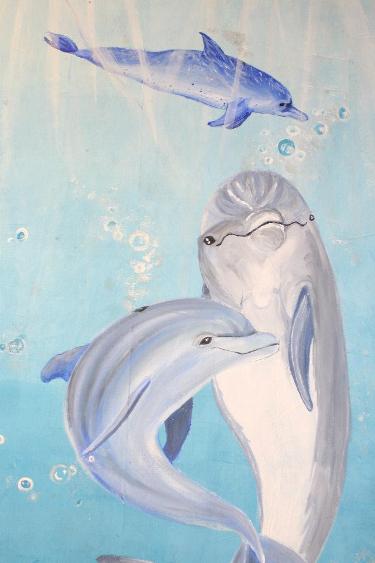
Top: Swimming Penguins, Center: Whales, Bottom: Dolphins; Details of 9' x 6' Canvases by Muralist Kristina Elaine Greer prepared for St. John's United Methodist Church in Staunton, Virginia

Xaver Wilhelmy's Design for a memorial at the World Trade Center site in New York. The memorial features a 3000 pipe organ to give a voice to everyone who's voice was lost on that terrible day. Rendering by Bob Kirchman
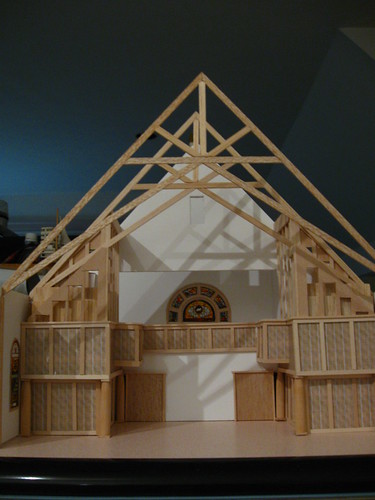
Xaver Wilhelmy's design for a pipe organ enclosure for St. John's Evangelical Lutheran Church in Davis West Virginia. Model by Bob Kirchman and Kristina Elaine Greer.
The Creative Mandate of Bezalel and Oholiab
Exodus 35 and 36, Skill, Ability and Knowledge
Then Moses said to the Israelites, “See, the Lord has chosen Bezalel son of Uri, the son of Hur, of the tribe of Judah, and he has filled him with the Spirit of G-d, with wisdom, with understanding, with knowledge and with all kinds of skills — to make artistic designs for work in gold, silver and bronze, to cut and set stones, to work in wood and to engage in all kinds of artistic crafts. And he has given both him and Oholiab son of Ahisamak, of the tribe of Dan, the ability to teach others. He has filled them with skill to do all kinds of work as engravers, designers, embroiderers in blue, purple and scarlet yarn and fine linen, and weavers—all of them skilled workers and designers.
So Bezalel, Oholiab and every skilled person to whom the Lord has given skill and ability to know how to carry out all the work of constructing the sanctuary are to do the work just as the Lord has commanded.”
Then Moses summoned Bezalel and Oholiab and every skilled person to whom the Lord had given ability and who was willing to come and do the work. They received from Moses all the offerings the Israelites had brought to carry out the work of constructing the sanctuary." -- Exodus 35:30 - 36:3
In Genesis, G-d invited mankind into the studio to name His creation. Mankind was also given the mandate to 'replenish' creation. When G-d chose to work through a specific people as part of his purpose, he again invited those He had created into His work. Bezalel and Oholiab are specifically mentioned by name. Bezalel, it says, is filled with the "Spirit of G-d, with wisdom, with understanding, with knowledge and with all kinds of skills." Clearly G-d is the giver of artistic gifts. Bezalel and Oholiab both are given the ability to teach by G-d. In the Tabernacle, G-d has these artisans construct the space that He will occupy!
The cubic Sanctuary, the Ark, the tools, fabrics and furnishings were all inspired designs executed by inspired artisans. The Presence of G-d would transform Israel, but Israel participated in building the place for the Presence! Later this same scheme would be repeated in stone and cedarwood for the Temple of Solomon. That form would be repeated in the rebuilt Temple of Zerubbabel's day. The Prophet Haggai again called the people to the work of G-d. Haggai ends his writings looking to a time when G-d will establish His throne in Heaven and on Earth.
In Isaiah 60 and Revelation 21, 22 we see the reign of G-d established and a New Heaven and New Earth. The form of Jerusalem described in Revelation is a cube large enough to encompass all of mankind! Here is restoration of fellowship with G-d and a return to that close fellowship seen in Genesis before the fall. Today the artist who has faith is uniquely equipped -- and called to the building of the Kingdom of Heaven! We possess a mandate to replenish the Earth, to use our gifts in the building of that which G-d is bringing about.
Consider the mission of The Culture House in Kansas City, Missouri. Janie B. Cheaney of World Magazine describes it like this: "an arts organization... that brings a Christian ethos of excellence for the sake of others and cultural leadership for its students." Founded by Jeremiah Enna, the Culture House offers programs in visual arts, dance and theatre... all from a perspective of submitting these gifts to G-d's purpose. In a recent production: Underground, the theatre group tackled the issue of slavery.
The popular narritive often approaches this narritive from the perspective that "America is evil." Underground's prooducers said instead: "we wanted to show America overcoming evil." Stressing the role of the Church in abolishing slavery, their narrative became: "G-d is the Hero!" In the Centuries past, faith was the inspiration for building great cathedrals and transformative movements in culture. Alvin Schmidt documents much of this in his book: Under the Influence. It is no stretch to conclude that much of our present tolerance for diversity springs from the influence of faith.
In the writings of Moses there are specific protections given to aliens living among the Israelites. In Genesis 12:3 G-d says to Abraham: "...all peoples on Earth will be blessed through you," giving a unique insight into the Divine Heart. The line of David includes Rahab (the woman of Jerico who hid the spies) and Ruth the Moabite. Moses himself had a Cushite wife (she was black). In Isaiah 60 we hear G-d's Heart speak:
Arise, shine, for your light has come, and the glory of the Lord rises upon you. See, darkness covers the earth and thick darkness is over the peoples, but the Lord rises upon you and his glory appears over you. Nations will come to your light, and kings to the brightness of your dawn." -- Isaiah 60:1-3
Foreigners will rebuild your walls, and their kings will serve you. Though in anger I struck you, in favor I will show you compassion. Your gates will always stand open, they will never be shut, day or night, so that people may bring you the wealth of the nations -- their kings led in triumphal procession. For the nation or kingdom that will not serve you will perish; it will be utterly ruined. The glory of Lebanon will come to you, the juniper, the fir and the cypress together, to adorn my sanctuary; and I will glorify the place for my feet. The children of your oppressors will come bowing before you; all who despise you will bow down at your feet and will call you the City of the Lord, Zion of the Holy One of Israel." -- Isaiah 60:10-14
Looking forward to G-d's transformative work, the artist of faith has a unique place and unique giftings to speak into his or her world.
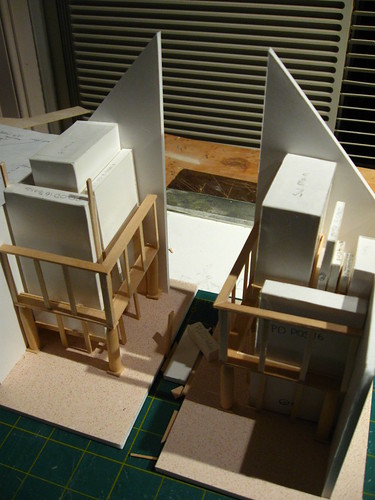
Mr. Wilhelmy worked out the placement of wind chests and pipes using the model built by the Kirchman Studio.
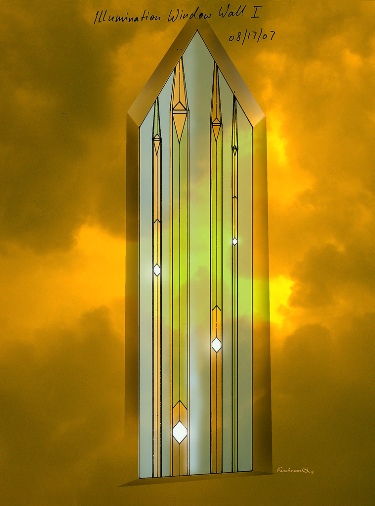
Xaver Wilhelmy's design for functional stained glass organ pipes embedded in a window. Rendering by Xaver Wilhelmy and Bob Kirchman
Thoughts on Purpose in Life's Work
Every Person's Calling to Build G-d's Kingdom

Painted glass vase by Carmen Rose Shenk.
I came upon this quotation which seems to recast significantly the purpose we so diligently seek for our lives. It is worth reflecting on these truths in a world where our retirement funds are disappearing, our masterpieces fade and our trophies tarnish. There is a better place to invest our time and treasure... that Kingdom that was the hope of the faithful in Hebrews 11:
But what what we can and must do in the present, if we are obedient to the gospel, if we are following Jesus, and if we are indwelt, energized, and directed by the Spirit, is to build for the kingdom. This brings me back to 1 Corinthians 15:58 once more: what you do for the Lord is not in vain. You are not oiling the wheels of a machine that's about to roll over a cliff. You are not restoring a great painting that's shortly going to be thrown on the fire. You are not planting roses in a garden that's about to be dug up for a building site. You are -- strange though it may seem, almost as hard to believe as the resurrection itself -- accomplishing something that will become in due course part of G-d's new world. Every act of love, gratitude and kindness; every work of art or music inspired by the love of G-d and delight in the beauty of his creation; every minute spent teaching a severely handicapped child to read or walk; every act of care and nurture, of comfort and support, for one's fellow human beings and for that matter one's fellow nonhuman creatures; and of course every prayer, all Spirit-led teaching, every deed that spreads the gospel, builds up the church, embraces and embodies holiness rather than corruption, and makes the name of Jesus honored in the world -- all of this will find its way, through the resurrecting power of G-d, into the new creation that G-d will one day make. That is the logic of the mission of G-d." -- N. T. Wright, Surprised by Hope, Rethinking Heaven, the Resurrection, and the Mission of the Church, page 208.
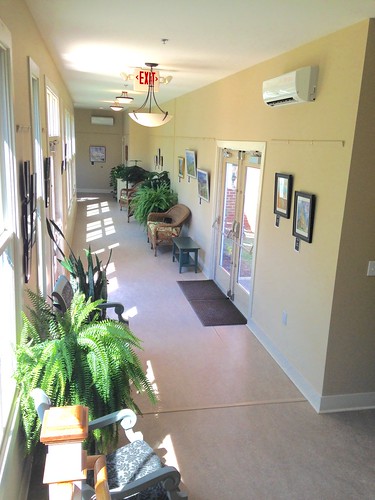
A view of the show 'WONDER' at Tabor Presbyterian Church in Crozet, Virginia.

The America I Love

Raven's Roost, on the Blue Ridge Parkway in Virginia.
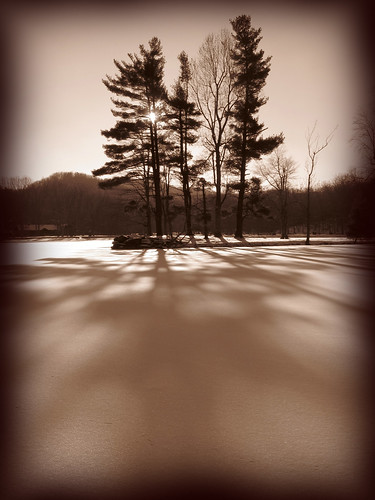
The Island in Sherando Lake, George Washington National Forest in Virginia.
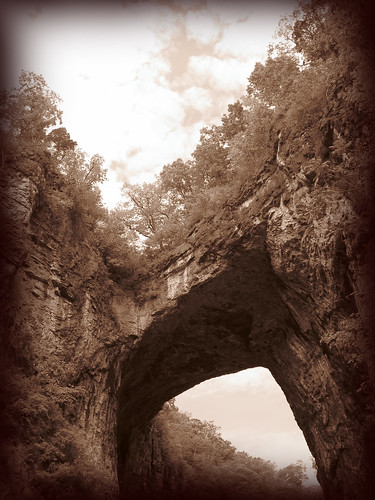
The Monacans, an eastern Siouan nation, who lived in the area for an estimated 10,000 years called the Natural Bridge of Virginia “Mohomony,” or “The Bridge of G-d.”
